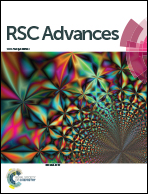Effects of Mo alloying on stability and diffusion of hydrogen in the Nb16H phase: a first-principles investigation
Abstract
First-principles calculations and the method of climbing-image nudged elastic band were used to investigate the effects of Mo alloying on the structural stability, mechanical properties, and hydrogen-diffusion behavior in the Nb16H phase. The Nb12Mo4H phase (26.5 at% Mo) was found to be the most thermodynamically stable structure, with a low ΔHf value (−0.26 eV) and high elastic modulus. Calculations revealed that the tetrahedral interstitial site (TIS) was the predominant location of H in both Nb16H and Nb12Mo4H phases. The calculated H-diffusion energy barrier and the diffusion coefficient of the Nb12Mo4H phase were 0.153 eV and 5.65 × 10−6 cm2 s−1 (300 K), respectively, which suggest that the addition of Mo would lead to a lower energy barrier and high diffusion coefficients for the Nb16H phase, thus improving the hydrogen-permeation properties of Nb metal.



 Please wait while we load your content...
Please wait while we load your content...